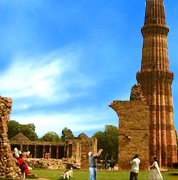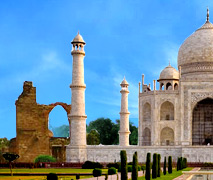 Agra
is said to be founded in 1475 during the reign of Raja Badal Singh.
Mughal monarchs transformed the land into one of the great centres of
art, culture, learning and commerce. Massive monuments, majestic
buildings and still flourishing arts and crafts including leatherwork
and pietra dura marble-inlay work along with delicious Mughal cuisine
have now become an inseparable part or more, the identity of the city.
Besides Taj, many other magnificent monuments are a testimony to the
zenith and golden period of the Mughal architecture.
Agra
is said to be founded in 1475 during the reign of Raja Badal Singh.
Mughal monarchs transformed the land into one of the great centres of
art, culture, learning and commerce. Massive monuments, majestic
buildings and still flourishing arts and crafts including leatherwork
and pietra dura marble-inlay work along with delicious Mughal cuisine
have now become an inseparable part or more, the identity of the city.
Besides Taj, many other magnificent monuments are a testimony to the
zenith and golden period of the Mughal architecture.Agra City
India's top tourist attraction, Taj Mahal is the ultimate requiem of love, from a great Mughal Emperor to his beloved. Made up of white marble, this mausoleum has immortalized Agra as the City of the Taj. Agra had been the chosen city of Mughals for years as it was close to Delhi. However, the history of Agra is much more older than the times of Mughals. The great Hindu epic 'Mahabharat' refers to 'Agraban' as an integral part of the Brij Bhumi or the land of Lord Krishna. It is claimed that this was the region of Agra, covered by forests then. There is Agra Fort and Itmad-ud-daulah that are gems of Mughal architectural style. Babur laid out the first formal Persian garden here on the banks of the River Yamuna. Sikandra, just outside Agra, is the beautiful garden mausoleum of Akbar. Hardly, any tourists go back from India without visiting Agra, if only for the seventh wonder, Taj Mahal.
Monuments of Agra
Shahjahan built Taj Mahal, the seventh wonder of the world, in memory of his beloved wife, Mumtaz Mahal, who died giving birth to their 14th child. Itmad-ud-daulah is the tomb of Mirza Ghiyas Beg, Emperor Jehangir's father - in- law. Standing in the centre of a luxurious Persian garden, it is an architectural jewel of its times. 10 km from the city centre of Agra, the mausoleum of Akbar, Sikandra, is a perfect amalgamation of Hindu, Christian, Islamic, Buddhist, Jain architectural styles. 40 km from Agra, the city of Fatehpur Sikri was built in the honor of the Sufi saint Sheikh Salim Chisti by Emperor Akbar. The city was intended to embody the noble ideals, and the humanitarian bent of this dynamic emperor. The finest monuments within this area are the Diwan - i - Am, Diwan - i - Khas, Panch Mahal, Jama Masjid, Panch Mahal, Buland Darwaza and the tomb of Saint Sheikh Salim Chisti. There are several monuments at Agra but the most important ones have been covered below:
1. Taj Mahal,
2. Itmad-ud-daulah,
3. Sikandra, and
4. Fatehpur Sikri.
Forts & Palaces of Agra
Agra became one of the principal cities of the Mughal Empire, especially, after the death of Ibrahim Lodi at Panipat in 1526 when Akbar chose it as his capital. He laid the foundations of the fort of Agra. The construction was started in 1565 and was completed in about eight years at a cost of thirty-five lakhs of rupees under the superintendence of Qasim Khan Mir Barr-u-Bahr. This fort was just one of the many large fortified residences that the emperor wanted to have at various strategic points of his empire. According to contemporary chroniclers like Abul Fazal the fort contained over five hundred buildings. But later on Akbar's descendants added new buildings, mainly in marble to the fort and demolished the old ones. During Akbar's time Jamuna was a mighty river and it touched the fort. A large number of ghats were built during Akbar's period. Some of the ghats were meant for handling goods and some particularly reserved for use by the harem inmates. Covered passages were specifically built for this purpose.
Agra Fort
On the shores of River Yamuna, to the northwest of the Taj Mahal, Emperor Akbar started a majestic fort, which gained Jehangir and Shah Jahan as its future benefactors who added rose-red sandstone and marble buildings to it respectively. Within 2.5- km-long and 20 feet high fortified walls, the premises of the fort houses many visionary palaces, such as the Jahangir Palace and the Khas Mahal, audience halls, such as the Diwan-i-Khas; and two very beautiful mosques.
Agra Tourism
No trip to India is complete without a visit to the Taj. One of the most beautiful places in the world, Taj Mahal is a feast for the eyes and a pilgrimage to the hearts of the lovers. It touches new heights of beauty and grace. There is Agra Fort, whose sheer vastness would have made up for its significance even without its numerous pretty buildings and edifices. The city of mausoleums, Agra has two more remarkable tombs that are worth beholding - Sikandra, the grand mausoleum of Akbar, the father of Jehangir and Itmad-ud-daulah, the tomb of Mirza Ghiyas Beg, the father-in-law of Jehangir. Fatehpur Sikri is not only for the pilgrims but is also an important tourist attraction with its wonderful edifices.
Excursions in Agra
Mathura and Vrindavan are two famous places where Lord Krishna was born and spent most of his childhood. They are the best places to observe the religious heritage of India. The holy towns positioned along the shores of River Yamuna are mentioned both in history and mythology. The other destination is the ultimate pilgrimage centre for Hindus, Varanasi (also popularly known as Benaras or Kashi), which is one of the oldest living cities in the world. Besides its temples and ghats, it is also known as a seat of learning, music and dance. The silk sarees, betel leaf and gold and silver threadwork of the city is also very famous.
Agra Hotels : Mughal Sheraton - Jaypee Palace - Hotel Taj View - Trident Hilton
1. Mathura,
2. Vrindavan, and
3. Varanasi.












